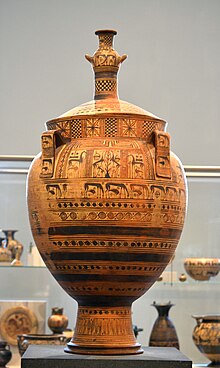Cesnola crater
The Cesnola crater or the Cesnola vase is the name vase of the late geometric - Euboean vase painter Cesnola painter . The period around 750 to 740 BC The crater dated to the 4th century BC has an unusual shape and shows some innovations in the decoration.
The crater, including the corresponding lid, the handle of which is worked as a miniature hydria , is 114.9 centimeters high. It was found in a monumental tomb in Kourion on Cyprus and came to the collection of the finder Luigi Palma di Cesnola in the collection of antiquities of the Metropolitan Museum of Art in New York in 1874 , where it is today under the inventory number 74.51.965 as one of the central pieces of the Gallery 152 (Archaic Greek Art of the Seventh and Sixth Centuries BC) on the east side of the Robert and Renée Belfer Court . The crater is shown standing on a base without a showcase and can be viewed from all sides. In addition to the Cesnola vase, two other oinochoes are said to have been found, one of which is also attributed to the Cesnola painter.
In his work, the painter combines the traditions of the Near East with influences from the Greek motherland and the Greek islands. The egg-shaped vase body stands on a separately manufactured, medium-high base that was connected in a later production process before the fire. The mouth is set off like the neck of neck amphorae . Four wide, ribbon-shaped handles are attached to the shoulder at regular intervals. They protrude above the neck at their highest points, but are reconnected to the body and not the neck. The corresponding lid has been preserved. The long handle ends in a miniature hydria. The base, neck, lid and, above all, the lower half of the body of the vase are provided with typical geometric patterns: filled and unfilled spirals, circles, wide and narrow stripes. The upper part of the vessel body is decorated with two animal friezes, the hydria of the lid with three small friezes and the handles with individual animals. The lower frieze of the body shows long-legged horses grazing typical of geometric vases of the time, a large bird (possibly a crane) is depicted between each of their legs. The main frieze shows deer or goats as the central picture, which put their front legs on a little tree, the tree of life, in order to be able to nibble on it better. The animal on the left is suckling a young. In addition, a stored animal is shown in the upper part. Animals that flank a sacred tree are taken from the art of the Near East. The panels next to the main picture, like the lower frieze, each show a horse and large birds between their legs. The free space is filled with a double ax. These axes are echoes of the Minoan art of the second millennium BC. The animals on the tree, like the filled, hand-painted spirals, are motifs that the Cesnola painter introduced into the repertoire of Greek vase painters with this vase.
The origin of the vase and thus that of the artist has been discussed for a long time since the 1870s. In terms of provenance, Naxos was the main topic of discussion, which was also suggested as the production site. In the meantime, clay analyzes and new finds assigned to the painter have proven that the vase was made on Euboea .
literature
- John Nicolas Coldstream : The Cesnola-Painter. A change of address. In: Bulletin of the Institute of Classical Studies Volume 18, 1971, pp. 1-15 ( digitized version ).
- Peter P. Kahane : Iconological research on Greco-geometric art. The Cesnola crater from Kourion in the Metropolitan Museum. In: Antike Kunst Volume 16, 1973, pp. 114-138.
- Nota Kourou: Euboea and Naxos in the Late Geometric Period. The Cesnola Style. In: Michel Bats, Bruno d'Agostino (ed.): Euboica. L'Eubea e la presenza Euboica in Calcidica e in Occidente. Atti del Convegno Internazionale di Napoli 13-16 November 1996 (= AION. Annali del Seminario di Studi del Mondo Classico. Sezione di Archeologia e Storia antica , Volume 12). Naples 1998, pp. 167-178. ( Digitized version )
- Rolf Hurschmann : Cesnola painter. In: The New Pauly (DNP). Volume 2, Metzler, Stuttgart 1997, ISBN 3-476-01472-X , Sp. 1075 f.
- John Boardman : Early Greek Vase Painting. 11th - 6th Century BC. A Handbook (= World of Art ). Thames and Hudson, London 1998, ISBN 0-500-20309-1 , p. 28.
- Mary B. Moore: Corpus Vasorum Antiquorum . The Metropolitan Museum of Art Fascicle 5, USA Fascicle 37: Greek Geometric and Protoattic Pottery. Metropolitan Museum of Art / Philipp von Zabern, New York and Mainz 2004, ISBN 3-8053-3238-6 , plates 46-49 ( review ).
- Carlos A. Picón, Joan R. Mertens, Elizabeth J. Milleker, Christopher S. Lightfoot, Seán Hemingway: Art of the Classical World in the Metropolitan Museum of Art. Greece - Cyprus - Etruria - Rome. Yale University Press, New Haven and London 2007, ISBN 978-1-58839-219-0 , pp. 47 and 413.
Web links
- Terracotta krater with lid surmounted by a small hydria in the online catalog of the Metropolitan Museum of Art (English)



